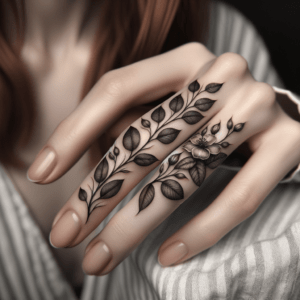Finger Tattoo Ideas
Get inspired for your new finger tattoo by browsing the over 300 AI-generated options in our gallery. Each of these finger tattoo designs can be used on its own or combined with other patterns to create a unique expression of your personality. You can also use them as inspiration to create your own original finger tattoo with our AI driven design tool.
No results found!

Finger Tattoo

Single Continuous Line Heart…

Minimalist Arrow Pointing Down…

Small Infinity Symbol On…

Small Wave Pattern On…

Minimalist Butterfly On The…

Simple Moon And Star…

Delicate Floral Vine On…

Delicate Rosebud On The…

Minimalist Arrow On The…

Tiny Heart Outline On…

Minimalist Star On The…

Small Anchor On The…

Single Line Cat Outline…

Tiny Butterfly On The…

Delicate Floral Vine On…

Single Line Flower On…

Delicate Tree On The…

Tiny Infinity Symbol On…

Tiny Paw Print On…

Small Cloud On The…

Dainty Bird On The…

Delicate Branch On The…

Small Star On The…

Tiny Arrow On The…

Tiny Moon On The…

Tiny Dragonfly On The…

Dainty Elephant On The…

Tiny Star Constellation On…
Didn’t Find What You’re Looking For?
Finger Tattoo Designs & Ideas
Popular Finger Tattoo Styles
Because of the smaller space in which they are placed, finger tattoos often have very specific styles. Some of the more popular ones are:
- Block letters – You’ll find these finger tattoos used across the knuckles.
- Dotwork – This tattoo style uses small dots to make a big statement.
- Jewelry – One finger tattoo design style mimics the look of rings and other pieces of jewelry.
- Minimalist designs – These can be things like symbols or art lines.
Best Finger Tattoo Placements
Not every finger tattoo is intended for public discussion. Some can be placed in more discreet locations to keep the meaning of the finger tattoo more personal.
Popular places for finger tattoos are:
- Across the knuckles
- On the outside of the forefinger
- Right above the nail
- On the inside of the finger
- On the palm-side of the finger
Men’s Finger Tattoos Ideas
Many men choose to get a finger tattoo as a way to make a statement. They will often choose designs with bold lines and with very little, if any at all, color. Among the more popular options are:
- Brass knuckles – Men wishing to embrace their tough-side will get brass knuckles tattooed across their fingers. This can look especially good when done in 3D.
- Club/military symbols – A common finger tattoo is to get the symbol of a fraternal club or military organization. This could be the army insignia or the Freemason’s symbol.
- Words – Your choice of finger tattoo makes a statement. And you can quite literally make a statement when you add words or a short phrase to your hands. While many women will do this with a thin, elegant line down the side of their forefinger men often choose to be more direct. They will place the words, boldly and a letter at a time, across their knuckles.
Women’s Finger Tattoos Ideas
Finger tattoos for women tend to be elegant and light, almost “wispy.” Some of the more popular styles include:
- Fashion ring – This finger tattoo stretches from your third knuckle to your second one with an ornate design on the top of your finger. The underside of your finger has the band that acts as if it is keeping the design in place.
- Letters – They don’t need to spell anything or be particularly ornate. This finger tattoo design is just a way for you to commemorate important people of places in your life.
- Matching patterns – Best friends, couples or family members may want to get the very same finger tattoo as a sign of their connection.
- String – This finger tattoo design is becoming an increasingly popular way to commemorate a moment or memory. It is a thin string with a bow tied at the side.
- Standard ring – A simple, subtle finger tattoo that proclaims your commitment to a person/place/ idea.
- Symbols – Some women use the finger tattoo to showcase a certain object that is important in their lives. They may choose a heart, a cross, a small book, an airplane, or a cat are some popular options.
- Zodiac symbols – An individual zodiac sign on each finger can be a way for a woman to celebrate her family or to express certain traits she associates with.
Finger Tattoo Meanings
Getting a finger tattoo is a sign of a person’s confidence in who they are and an expression of that. (Of course the actual design chosen will hold great meaning and importance to the wearer.) But overall, a finger tattoo can show that you have control of something or that you figuratively (or literally) have something wrapped around your fingers.
Create Your Own Finger Tattoo!
Popular Styles
Popular Placement
Related Ideas